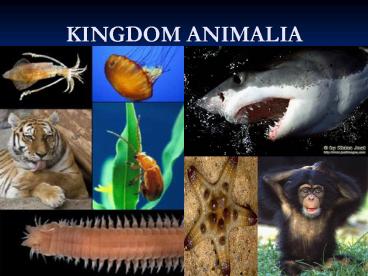KINGDOM ANIMALIA - PowerPoint PPT Presentation
1 / 12
Title:
KINGDOM ANIMALIA
Description:
Animals are grouped into about 35 phyla (mostly aquatic). Vertebrates make up one subphylum within the Phylum Chordata less than 5 ... Sea Anemone, Cnidarians) ... – PowerPoint PPT presentation
Number of Views:235
Avg rating:3.0/5.0
Title: KINGDOM ANIMALIA
1
KINGDOM ANIMALIA
2
General Info
- Of all the kingdoms of organisms, the animal
kingdom is the most diverse in appearance. - More than a million species of animals are known.
- Animals are grouped into about 35 phyla (mostly
aquatic). - Vertebrates make up one subphylum within the
Phylum Chordata less than 5 of all animal
species. - 95 of all animal species are invertebrates and
do not have a backbone. - Animals carry out the following essential
functions feeding, respiration, circulation,
excretion, response movement, and reproduction. - What animals represent the majority of all animal
species?
3
What is an animal?
- Animals are multicellular, heterotrophic,
eukaryotes. They take into their bodies
preformed organic molecules, they cannot
construct them from inorganic chemicals. Most do
this by ingestion. - Animals typically store their carbohydrate
reserves as glycogen. - Lack cell walls.
- Two types of tissues responsible for impulse
conduction and movement nervous tissue and
muscle tissue. - Reproduce sexually (most).
4
Early Development (Embryology)
- Animals that reproduce sexually begin life as a
zygote, or fertilized egg. The zygote undergoes
a series of divisions to form a blastula, which
is a hollow ball of cells. The blastula folds in
on itself, forming a single opening called a
blastopore. - The blastopore leads into a central tube that
runs the length of the developing embryo. This
tube becomes a digestive tract and is formed in
one of two ways. - 1. A protostome is an animal whose mouth is
formed from the blastopore. Most invertebrates
are protostomes. - 2. A deuterostome is an animal whose anus is
formed from the blastopore. The mouth is formed
second after the anus. All vertebrates are
deuterostomes.
5
- The cells of most animal embryos differentiate
into three layers called germ layers. - The cells of endoderm (innermost germ layer),
develop into the linings of the digestive tract
and respiratory system. - The cells of mesoderm (middle layer), give rise
to muscles and much of the circulatory ,
reproductive, and excretory organ systems. - The ectoderm (outermost layer), gives rise to
sense organs, nerves, and the outer layer of the
skin.
6
(No Transcript)
7
Body Symmetry
- With the exception of sponges, every kind of
animal exhibits some type of body symmetry in its
anatomy. - Many simple animals have body parts that repeat
around the center of the body. These animals
exhibit radial symmetry. (Ex. Sea Anemone,
Cnidarians) - In animals with bilateral symmetry, such as
crayfish, only a single imaginary plane can
divide the body into two equal halves. These
animals have right and left sides, front and back
ends, and upper and lower sides. - The anterior is the front end, and the posterior
is the back end. The dorsal is the upper side,
and the ventral is the lower side.
8
(No Transcript)
9
Cephalization
- Animals with bilateral symmetry usually display
cephalization. - Cephalization is the concentration of sense
organs and nerve cells at the front end
(anterior) of the body. - Animals with cephalization respond to the
environment more quickly and in more complex ways
than simpler animals can. - Animals with bilateral symmetry usually move with
the anterior end forward, so this end comes in
contact with new parts of the environment first.
10
Body Cavity Formation
- Most animals have a body cavity, or coelom, which
is a fluid filled space that lies between the
digestive tract and the body wall. - A coelom is important because it provides a space
in which internal organs can be suspended. This
space allows organs to grow and develop and
protects them from body movements. - In some animals, the coelom contains fluids that
are involved in circulation, feeding and
excretion.
11
(No Transcript)
12
Review Questions
- 1. What are the major characteristics that
distinguish animals from plants? - 2. Why is it not sufficient to classify animals
simply as multicellular heterotrophs? - 3. State the three germ layers found in most
animals and give an example of a tissue type or
organ system that arises from each. ) - 4. What conclusions can be drawn from the
observation that almost all animals undergo
similar development from zygote to blastula to
gastrula? - 5. A student submits a diagram of an embryo with
the three germ layers labeled. The title reads
Diagram of sponge embryo. Do you mark it right
or wrong? Explain. - 6. Distinguish between acoelomates,
pseudocoelomates, and coelomates. - 7. As animals became more complex, why was the
development of a coelom important? - 8. Describe the two types of body symmetry.
- 9. Which kind of symmetry has the fewest planes
of symmetry? - 10. Which form of symmetry is characteristic of
the highest animals? - 11. Explain why animals with radial symmetry show
no signs of cephalization. - 12. List the main body areas associated with
bilateral symmetry and state what each one means.
- 13. Is your head anterior or posterior to your
arms? Describe the location of your arms in
relation to your shoulders. - 14. Dorsal relates to
- a) the forward or head end of an animal b) the
back or upper surface of the animal - c) the lower side or belly of the animal d) the
tail end or the end away from the head of an
animal - 15. Radial symmetry is to sea stars as bilateral
symmetry is to - a) hydra b) jellyfish c) bony fish d) sand
dollars































